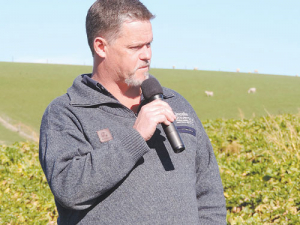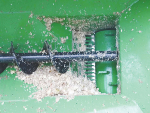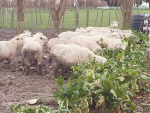High yielding and palatable, fodder beet allows the wintering of large numbers of sheep in a small area and frees pasture elsewhere on a farm.
Norwood farmers Peter and Tom Chamberlain began feeding fodder beet to ewes last year when they had surplus of the crop and their traditional rape crops had not yielded as well as expected.
While the sheep had to learn to eat it, once they got a taste for it they were away. Meadow and ryegrass straw was fed as a supplement initially and later they fed protein-rich lucerne baleage to offset fodder beet’s low protein content.
The ewes did so well on it that fodder beet is now part of the Chamberlains’ wintering system.
Dr Jim Gibbs from Lincoln University says unlike cattle, sheep do not need to be carefully transitioned onto the crop as it does not cause acidosis in ovine rumens.
It is more case of running them onto the crop for a couple of hours over a few days so the sheep get used to eating it. “They just need to get their head around it,” says Gibbs.
However, he adds, sheep must be vaccinated against clostridial diseases before going onto fodder beet because the crop’s high sugar content will feed the clostridial-causing bacteria.
Sheep also need more protein than cattle and while there is usually sufficient protein in the leaf, in crops with damaged leaves a high protein supplement will be necessary.
This need for protein is also the reason Gibbs recommends daily breaks, as this ensures the sheep are eating the leaf and the bulb. Longer breaks will see the sheep only eat the leaf on day one and then spend subsequent days just eating the bulb.
“You can have big problems with sleepy sickness when the sheep are just eating bulbs.”
James White from Seed Force says sheep farmers should be selecting varieties of fodder beet with low dry matter and a high proportion of good quality leaf.
He says these varieties (such as Brigadier) sit higher out of the ground, making them more accessible to sheep (and young cattle), but most importantly they produce a lot more leaf and will hang onto that leaf into winter when managed correctly.
Like Gibbs, White cautions against multi-day breaks. He says for sheep systems, if breaks are too long they will consume all the leaf first, leaving a bulb-only diet and insufficient protein for the remainder of the break.
While there is a growing awareness of the place of fodder beet in sheep systems, White says sheep farmers have been feeding beet to sheep for a long time, although because the crops can be so high yielding and stocking rates high, the areas grown are not huge.
“As long as you get the yield you don’t require a lot of land for sheep systems.”
He says farmers can run 150-200 ewes/ha and it’s the crop’s ability to hold many animals for about three months over winter that is its greatest appeal.
This allows farmers to build pastures over winter or run other classes of stock on the freed-up area.
White says lambs generally won’t finish on fodder beet, but the crop will hold these animals so they can be finished on spring pasture.
He urges anyone thinking about growing beet for sheep to get good advice from people with experience and expertise in growing and feeding the crop.
Key points
- Ability to carry a high stocking rate
- Leaf a critical component as a protein source
- Sheep must be vaccinated for clostridial diseases
- Breaks should be shifted daily – three days at most
- Lambs will not finish on fodder beet due to their higher protein requirements (they will be maintained)
- Paddock preparation is a key driver of crop yield
- Sub-soil pans or compaction will impact yield and crop performance
- Sow when conditions are suitable, soil temperatures are rising
- Seek advice from people with experience in growing and feeding the crop.



















